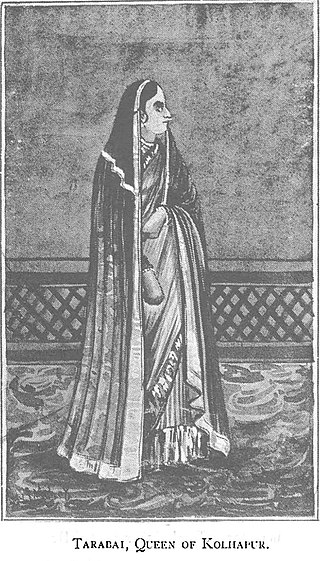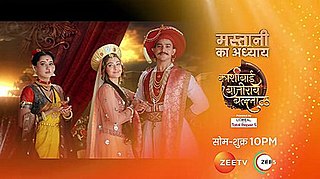Related Research Articles

Bajirao I, born as Visaji, was the 7th Peshwa of the Maratha Confederacy.

The Maratha Empire, also referred to as the Maratha Confederacy, was an early modern Indian empire and later a confederation that controlled large portions of the Indian subcontinent in the 18th century. Maratha rule formally began in 1674 with the coronation of Shivaji of the Bhonsle dynasty as the Chhatrapati. Although Shivaji came from the Maratha caste, the Maratha empire also included warriors, administrators, and other nobles from the Maratha and several other castes from what is known today as Maharashtra. The Maratha Kingdom was expanded into a full-fledged Empire in the 18th Century CE under the leadership of Peshwa Bajirao I.

Peshwa was second highest office in the Maratha Confederacy, next in rank and prestige only to that of the Chhatrapati. Initially serving as the appointed prime minister in the Maratha empire, the office became hereditary after the death of Shahu in 1749. During the reign of Shahu, the office of Peshwa grew in power and the Peshwas came to be the de facto rulers of the Maratha empire. However following the defeat of the Marathas in 1761, the office of the Peshwa became titular as well and from that point onwards served as the ceremonial head of the Confederacy underneath the Chhatrapati.

Balaji Baji Rao, often referred to as Nana Saheb I, was the 8th Peshwa of the Maratha Confederacy. He was appointed as Peshwa in 1740 upon the death of his father, the Peshwa Bajirao I.
Baji Rao may refer to

Shahu I was the fifth Chhatrapati of the Maratha Empire founded by his grandfather, Shivaji I. He was born into the Bhonsle family, and was the son of Sambhaji I and Yesubai. At a young age, he was taken into custody at the Siege of Raigad by Mughal emperor Aurangzeb, and held captive by the Mughals. He was released from captivity after the death of Aurangzeb in the hope of engineering an internecine struggle among the Maratha factions of Tarabai and Shahu. Raja Shahu emerged victorious in the bloody Battle of Khed and was crowned as Chhatrapati.

Balaji Vishwanath Bhat (1662–1720) was the first of a series of hereditary Peshwas hailing from the Bhat family who gained effective control of the Maratha Empire and the Mughal vassals of the Marathas during the early 18th century. Balaji Vishwanath assisted a young Maratha king Shahu to consolidate his grip on a kingdom that had been racked by civil war and persistently intruded on by the Mughals under Aurangzeb. He was called the Second Founder of the Maratha State. He secured a grant from the Mughal court that confirmed Shahu as the legitimate Mughal vassal, at the expense of his rival Sambhaji. Later, his son Bajirao I became the Peshwa.

Mastani was the daughter of Chhatrasal and Ruhani Bai Begum. She was the second wife of the Maratha Peshwa Baji Rao I. Her relationship within the Maratha Brahmin family has been subject of both admiration and controversy and well adapted in Indian novels and cinema.

Nana Fadnavis, born Balaji Janardan Bhanu, was a Maratha minister and statesman during the Peshwa administration in Pune, India. James Grant Duff states that he was called "the Maratha Machiavelli" by the Europeans.

Tarabai Bhosale (née Mohite) was the regent of the Maratha Empire from 1700 until 1708. She was the queen of Rajaram I, and daughter-in-law of the empire's founder Shivaji I. She is acclaimed for her role in keeping alive the resistance against Mughal occupation of Maratha territories after the death of her husband, and acting as the regent during the minority of her son, Shivaji II.

Malhar Rao Holkar was a noble subedar of the Maratha Empire, in present-day India. He was one of the early officers along with Ranoji Scindia to help spread the Maratha rule to northern states and was given the estate of Indore to rule by the Peshwas, during the reign of the Maratha emperor Shahu I. He was founder of the Holkar dynasty that ruled Malwa.

Chimaji Balaji Bhat (1707–1740), commonly referred to as Appa or Bhau, was the son of Balaji Vishwanath Bhat and the younger brother of Bajirao Peshwa of Maratha Empire. He was an able military commander who liberated the western coast of India from Portuguese rule. The high watermark of his career was the capture of Vasai fort from the Portuguese.

Sadashivrao Bhau Peshwa was son of Chimaji Appa and Rakhmabai and the nephew of Baji Rao I. He was a finance minister during the reign of Maratha emperor Rajaram II. He led the Maratha army at the Third Battle of Panipat.
Gopikabai was Peshwin of Maratha Empire, as the wife of Peshwa Balaji Baji Rao. She had a very orthodox religious upbringing and belief. After the death of Nanasaheb Peshwa, she tried to expand her power over the Peshwa and the administration. She influenced her son Madhavrao Peshwa, who by sidelining Raghunathrao at her urging, assumed control. However, after trying to interfere in administrative matters, namely to save her brother from punishment, she was confined to Nashik. In 1773 she was freed after the death of Madhavarao and went back to Pune. Afterwards, Gopikabai became part of the priestly class. She developed a rivalry with other women in the Peshwa's household. She was the mother of three successive Peshwas.
Umabai Dabhade was a prominent member of the Maratha Dabhade clan. The members of her family held the hereditary title senapati (commander-in-chief), and controlled several territories in Gujarat. After the deaths of her husband Khande Rao and her son Trimbak Rao, she exercised executive powers while her minor son Yashwant Rao remained the titular senapati. Her unsuccessful rebellion against Peshwa Balaji Baji Rao resulted in the downfall of the Dabhade family.

The Afghan-Maratha War was fought between the Afghan Empire under Ahmad Shah Durrani and the Maratha Empire and the Sikh Confederacy between 1758 and 1761. It took place in north-west India, primarily the region around Delhi and Punjab.

Damaji Rao Gaekwad was the second Maharaja of Baroda reigning from 1732 to 1768 until his death.
The Bhat Peshwa family earlier known as Bhat family is a prominent Indian Chitpavan Brahmin family who dominated India for around 100 years in the late 18th century and early 19th century. Most of the members in this family were the Peshwas in the Peshwa Era of the Maratha Empire, and Peshwa later became their family name. During their regime, most of the Indian subcontinent was under their control. The last Peshwa, Baji Rao II, was defeated by the British East India Company in the Third Anglo-Maratha War in 1818. The territory was annexed to the British East India Company's Bombay Presidency, and he was pensioned.
Peshwa Bajirao is an Indian Hindi historical drama television series, which broadcast from 23 January 2017 to 25 August 2017 on Sony TV. The series is based on a Peshwa of the Maratha Empire, Bajirao I, who ruled under the Chhatrapati known as Shahu. The series was produced by Sphere Origins of Sunjoy Waddhwa and creatively produced by Nilanjana Purkayasstha's company Invictus T Mediaworks. The series was aired on weekdays.

Kashibai Bajirao Ballal is an Indian historical drama based on Kashibai. It premiered on 15 November 2021 on Zee TV with Aarohi Patel as Young Kashi Bai and Venkatesh Pandey as Young Bajirao. On 21 March 2022, the story moved on several years and Riya Sharma portrays the lead role of Kashibai opposite Rohit Chandel who essays the role of Bajirao. It went off air on 19 August 2022, after completing 201 episodes.
References
- 1 2 Mehta, Jaswant Lal (2005). Advanced Study in the History of Modern India 1707–1813. Sterling Publishers Pvt. Ltd. p. 124. ISBN 9781932705546.
- 1 2 Rap;son, Edward James; Burn, Sir Richard (1965). The Cambridge History of India. CUP Archive. p. 407.
{{cite book}}: CS1 maint: multiple names: authors list (link) - ↑ Sandhya Gokhale (2008). The Chitpavans: social ascendancy of a creative minority in Maharashtra, 1818–1918. Sandhya Gokhale. p. 82. ISBN 9788182901322.
- 1 2 3 Mishra, Garima (3 January 2016). "Tracing Kashibai: The 'first' lady from Bhansali's Bajirao Mastani". The Indian Express. Retrieved 30 July 2017.
- ↑ Sardesai, Govind Sakharam (1948). New History of the Marathas: The expansion of the Maratha power, 1707-1772. Phoenix Publications. p. 60.
- 1 2 R. D. Palsokar, T. Rabi Reddy (1995). Bajirao I: an outstanding cavalry general. Reliance Pub. House. p. 53. ISBN 9788185972947.
- ↑ Prashant Hamine (15 December 2015). "Rare manuscripts of Peshwa history lie wrapped in government apathy". Afternoon DC . Archived from the original on 14 January 2016. Retrieved 4 January 2016.
- ↑ Charles Augustus Kincaid, Dattātraya Baḷavanta Pārasanīsa (1922). A History of the Maratha People: From the death of Shivaji to the death of Shahu. S. Chand. p. 180.
- ↑ Mehta, J. L. (2005). Advanced study in the history of modern India, 1707-1813. Slough: New Dawn Press, Inc. p. 124. ISBN 9781932705546.
- 1 2 I. P. Glushkova, Rajendra Vora (1999). Home, Family and Kinship in Maharashtra. Oxford University Press. p. 107. ISBN 9780195646351.
- 1 2 3 Garima Mishra (3 January 2016). "Kashibai: The first lady". Indian Express . Retrieved 4 January 2016.
- ↑ H. S. Bhatia (2001). Mahrattas, Sikhs and Southern Sultans of India: Their Fight Against Foreign Power. Deep Publications. p. 66. ISBN 9788171003693.
- ↑ Imprint, Volume 21. Business Press. 1981. p. 169.
- ↑ The Sikh Review, Volume 25, Issues 277–288. Sikh Cultural Centre. 1977. p. 48.
- ↑ B. R. Andhare (1984). Bundelkhand under the Marathas, 1720–1818 A.D.: a study of Maratha-Bundela relations, Volumes 1–2. Vishwa Bharati Prakashan. pp. 77–78.
- ↑ Jha, Subhash K (19 October 2015). "Bajirao Mastani review: This gloriously epic Priyanka, Deepika and Ranveer-starrer is the best film of 2015". Firstpost. Retrieved 19 October 2015.
- ↑ Maheshwri, Neha (May 27, 2017). "Ishita Ganguly to play the grown-up Kashibai in 'Peshwa Bajirao' - Times of India". The Times of India. Retrieved 30 July 2017.
- ↑ "When 9-year-old Aarohi Patel learnt Horse Riding in just 4 days for Zee TV's Kashibai Bajirao Ballal!". Tellychakkar.com. Retrieved 2021-11-15.